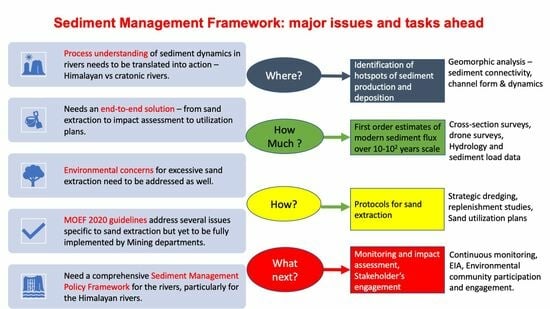Sustainable Silt Management in the Lower Kosi River, North Bihar, India: Demand Assessment, Investment Model and Socio-Economic Development
Abstract
1. Introduction
2. Study Area
3. Data and Methods
3.1. Sediment Volume Estimation and Criteria for Potential Solutions for Sediment Management
3.2. Investment Model and Business Plan
4. Results and Analysis
4.1. Hydrogeomorphic Analysis for ‘Hotspot’ Identification and Sediment Volume Estimation
4.2. Investment Model: Demand Assessment, Cost-Benefit Ratio, and Financial Analysis
4.2.1. Solution 1: Backfilling
- (a)
- Backfilling of roads and houses (up to the plinth level and in the compound)
- (b)
- Backfilling for the creation of habitat islands
- (c)
- Backfilling for large infra projects
4.2.2. Solution 2: Embankment
- (a)
- Raising the height of the embankment
- (b)
- Building road on embankment
4.3. Other Potential Opportunities
4.4. Key Risks of the Investment Model and Possible Mitigation Strategies
- Mandatory usage of silt for construction purposes may result in delay of the projects. There is a need for streamlined processes, clearly laid down policies, and adequate storage of silt.
- The strength of silt is generally poor as compared to other alternatives. To mitigate this, binding material may be added.
- Non-viability/infeasibility of silt utilization in detailed technical studies has been noted. To achieve this, there is a need for further testing of silt to make it feasible with mixture/subsidising silt by GoB.
- Non-availability of land for storage is a major problem and, therefore, it is proposed to sell directly from the embankment or place where dredged silt is kept.
- Land acquisition issues for the construction of habitat islands should be taken up on priority by GoB.
- The poor quality of the storage system needs to be resolved by building high-quality storage facilities to ensure safety in poor weather conditions/floods, etc.
- Non-acceptance of environmental studies and approvals from various government departments for road construction on embankments needs to be resolved. Additionally, the use of silt for other established activities should be promoted.
4.5. Proposed Sediment Management Framework
5. Conclusions
- The Kosi River is a highly sediment-charged river, and we estimate a total of 1114 million m3 of extractable sediments accumulated in the channel belt since the construction of the embankment (1972–2016). In the reaches falling in two prominent districts, Supaul and Saharsa, the total sediment volume is estimated to be 755 million m3 and 59 million m3, respectively.
- Given such large volumes of sediments, strategic dredging of sediments may be necessary from several reaches (hotspots of siltation) to stabilize the river and reduce the associated hazards. However, such dredging must be done following international practices and more importantly, must be commercially viable.
- Our study shows that with an initial investment of Rs 62.3 million (initial capital expenditure funding of the project), the annual benefit can be Rs 14.1 million from the different solutions.
- Our study suggests that various subfactors associated with two major solutions, backfilling and road construction, can consume up to 1.3 million m3 of silt dredged from Kosi River from Saharsa and Supaul districts, which can be worth Rs 335.8 million that can be utilized commercially on a yearly scale.
- Some of the solutions are entirely based on government expenditure, i.e., habitat island filling and raising embankment filling, which can cost up to Rs 114.3 million forecasted for a period of 10 years. Thus, based on the present analysis, it is evident that with low investment, a high revenue return distribution model can be set up. Also, if successful, it can be replicated and extrapolated at the state as well as national level.
- Apart from the sediment management framework, a strategic roadmap and implementation plans have also been proposed for short-term (1–2 years), medium-term (3–5 years), and long-term (6–10 years) approaches, for which specific recommendations have been provided based on the investment models presented in this work.
6. Limitations and Future Scope
Supplementary Materials
Author Contributions
Funding
Institutional Review Board Statement
Informed Consent Statement
Data Availability Statement
Acknowledgments
Conflicts of Interest
References
- Best, J. Anthropogenic Stresses on the World’s Big Rivers. Nat. Geosci. 2019, 12, 7–21. [Google Scholar] [CrossRef]
- Hackney, C.R.; Darby, S.E.; Parsons, D.R.; Leyland, J.; Best, J.L.; Aalto, R.; Nicholas, A.P.; Houseago, R.C. River Bank Instability from Unsustainable Sand Mining in the Lower Mekong River. Nat. Sustain. 2020, 3, 217–225. [Google Scholar] [CrossRef]
- Kondolf, G.M. River Restoration and Meanders. Ecol. Soc. 2006, 11, 42. [Google Scholar] [CrossRef]
- Torres, A.; Brandt, J.; Lear, K.; Liu, J. A Looming Tragedy of the Sand Commons. Science 2017, 357, 970–971. [Google Scholar] [CrossRef] [PubMed]
- Bendixen, M.; Best, J.; Hackney, C.; Iversen, L.L. Time Is Running out for Sand. Nature 2019, 571, 29–31. [Google Scholar] [CrossRef] [PubMed]
- Koehnken, L.; Rintoul, M.S.; Goichot, M.; Tickner, D.; Loftus, A.C.; Acreman, M.C. Impacts of Riverine Sand Mining on Freshwater Ecosystems: A Review of the Scientific Evidence and Guidance for Future Research. River Res. Appl. 2020, 36, 362–370. [Google Scholar] [CrossRef]
- UNEP-GEAS. Sand, Rarer than One Thinks. Environ. Dev. 2014, 11, 208–218. [Google Scholar] [CrossRef]
- Gavriletea, M.D. Environmental Impacts of Sand Exploitation. Analysis of Sand Market. Sustainability 2017, 9, 1118. [Google Scholar] [CrossRef]
- USGS Sand and Gravel (Industrial). Silica Statistics and Information; USGS: Reston, VA, USA, 2011; Volume 1. [Google Scholar]
- Bendixen, M.; Iversen, L.L.; Best, J.; Franks, D.M.; Hackney, C.R.; Latrubesse, E.M.; Tusting, L.S. Sand, Gravel, and UN Sustainable Development Goals: Conflicts, Synergies, and Pathways Forward. One Earth 2021, 4, 1095–1111. [Google Scholar] [CrossRef]
- National Industrial Sand Association (NISA). What Is Industrial Sand? Available online: https://wisconsinsand.org/industrial-sand/ (accessed on 30 June 2023).
- Filho, W.L.; Hunt, J.; Lingos, A.; Platje, J.; Vieira, L.W.; Will, M.; Gavriletea, M.D. The Unsustainable Use of Sand: Reporting on a Global Problem. Sustainability 2021, 13, 3356. [Google Scholar] [CrossRef]
- Kondolf, G.M. Hungry Water: Effects of Dams and Gravel Mining on River Channels. Environ. Manag. 1997, 21, 533–551. [Google Scholar] [CrossRef] [PubMed]
- Kim, T.T.; Huong, N.T.M.; Huy, N.D.Q.; Tai, P.A.; Hong, S.; Quan, T.M.; Bay, N.T.; Jeong, W.K.; Phung, N.K. Assessment of the Impact of Sand Mining on Bottom Morphology in the Mekong River in an Giang Province, Vietnam, Using a Hydro-Morphological Model with Gpu Computing. Water 2020, 12, 2912. [Google Scholar] [CrossRef]
- Bhattacharya, R.; Dolui, G.; Das Chatterjee, N. Effect of Instream Sand Mining on Hydraulic Variables of Bedload Transport and Channel Planform: An Alluvial Stream in South Bengal Basin, India. Environ. Earth Sci. 2019, 78, 303. [Google Scholar] [CrossRef]
- Vasilopoulos, G.; Quan, Q.L.; Parsons, D.R.; Darby, S.E.; Tri, V.P.D.; Hung, N.N.; Haigh, I.D.; Voepel, H.E.; Nicholas, A.P.; Aalto, R. Establishing Sustainable Sediment Budgets Is Critical for Climate-Resilient Mega-Deltas. Environ. Res. Lett. 2021, 16, 064089. [Google Scholar] [CrossRef]
- Eslami, S.; Hoekstra, P.; Nguyen Trung, N.; Ahmed Kantoush, S.; Van Binh, D.; Duc Dung, D.; Tran Quang, T.; van der Vegt, M. Tidal Amplification and Salt Intrusion in the Mekong Delta Driven by Anthropogenic Sediment Starvation. Sci. Rep. 2019, 9, 18746. [Google Scholar] [CrossRef]
- Julien, P.Y.; Vensel, C.W. Review of Sedimentation Issues on the Mississippi River. 2005. Available online: https://www.engr.colostate.edu/~pierre/ce_old/Projects/Rising%20Stars%20Website/Vensel-Mississippi-05.pdf (accessed on 30 June 2023).
- Förstner, U.; Owens, P.N. Sediment Quantity and Quality Issues in River Basins. In Sediment Dynamics and Pollutant Mobility in Rivers; Westrich, B., Förstner, U., Eds.; Springer: Berlin/Heidelberg, Germany, 2007; pp. 1–34. [Google Scholar]
- Bailey, S.E.; Estes, T.J.; Schroeder, P.R.; Myers, T.E.; Rosati, J.D.; Welp, T.L.; Lee, L.T.; Gwin, W.V.; Averett, D.E. Sustainable Confined Disposal Facilities for Long-Term Management of Dredged Material; Engineer Research and Development Center: Vicksburg, MS, USA, 2010; 23p. [Google Scholar]
- Vogt, C.; Hartman, G. Dredging Practices and Environmental Considerations BT—Encyclopedia of Sustainability Science and Technology; Meyers, R.A., Ed.; Springer: New York, NY, USA, 2017; pp. 1–28. ISBN 978-1-4939-2493-6. [Google Scholar]
- Owens, P.N. Conceptual Models and Budgets for Sediment Management at the River Basin Scale. J. Soils Sediments 2005, 5, 201–212. [Google Scholar] [CrossRef]
- Milliman, J.D.; Syvitski, J.P.M. Geomorphic/Tectonic Control of Sediment Discharge to the Ocean: The Importance of Small Mountainous Rivers. J. Geol. 1992, 100, 525–544. [Google Scholar] [CrossRef]
- Higgitt, D.L. Large Rivers and Sediment Cascades: Connectivity and Discontinuity. Int. J. Eros. Control Eng. 2012, 5, 9–15. [Google Scholar] [CrossRef][Green Version]
- Sinha, R.; Gupta, A.; Mishra, K.; Tripathi, S.; Nepal, S.; Wahid, S.M.; Swarnkar, S. Basin-Scale Hydrology and Sediment Dynamics of the Kosi River in the Himalayan Foreland. J. Hydrol. 2019, 570, 156–166. [Google Scholar] [CrossRef]
- Sinha, R.; Sripriyanka, K.; Jain, V.; Mukul, M. Avulsion Threshold and Planform Dynamics of the Kosi River in North Bihar (India) and Nepal: A GIS Framework. Geomorphology 2014, 216, 157–170. [Google Scholar] [CrossRef]
- Mishra, K.; Sinha, R.; Jain, V.; Nepal, S.; Uddin, K. Towards the Assessment of Sediment Connectivity in a Large Himalayan River Basin. Sci. Total Environ. 2019, 661, 251–265. [Google Scholar] [CrossRef] [PubMed]
- Mishra, D.K. The Kosi and the Embankment Story. Econ. Polit. Wkly. 2008, 43, 47–52. [Google Scholar]
- Sinha, R. The Great Avulsion of Kosi on 18 August 2008. Curr. Sci. 2009, 97, 429–433. [Google Scholar]
- Sinha, R.; Singh, S.; Mishra, K.; Swarnkar, S. Channel Morphodynamics and Sediment Budget of the Lower Ganga River Using a Hydrogeomorphological Approach. Earth Surf. Process. Landf. 2023, 48, 14–33. [Google Scholar] [CrossRef]
- Jenks, G.F.; Caspall, F.C. Error on Choroplethic Maps: Definition, Measurement, Reduction. Ann. Assoc. Am. Geogr. 1971, 61, 217–244. [Google Scholar] [CrossRef]
- Coulson, M.R.C. In the Matter of Class Intervals for Choropleth Maps: With Particular Reference to The Work of George F Jenks. Cartogr. Int. J. Geogr. Inf. Geovisualization 1987, 24, 16–39. [Google Scholar] [CrossRef]
- Weihrich, H. The TOWS Matrix A Tool for Situational Analysis. Long Range Plan. 1982, 15, 54–66. [Google Scholar] [CrossRef]
- Lynch, R. Strategic Management; Pearson Education Limited: Harlow, UK, 2009. [Google Scholar]
- Yüksel, I. Developing a Multi-Criteria Decision Making Model for PESTEL Analysis. Int. J. Bus. Manag. 2012, 7, 52–66. [Google Scholar] [CrossRef]
- Issa, T.; Chang, A.P.V.; Issa, T. Sustainable Business Strategies and PESTEL Framework. GSTF Int. J. Comput. 2010, 1, 73–80. [Google Scholar] [CrossRef]
- Song, J.; Sun, Y.; Jin, L. PESTEL Analysis of the Development of the Waste-to-Energy Incineration Industry in China. Renew. Sustain. Energy Rev. 2017, 80, 276–289. [Google Scholar] [CrossRef]
- Sinha, R.; Gaurav, K.; Mishra, K.; Gupta, S. The Kosi Megafan, India. In Fluvial Megafans on Earth and Mars; Cambridge University Press: Cambridge, UK, 2023; pp. 202–218. [Google Scholar]
- Sinha, R.; Jain, V. Flood Hazards of North Bihar Rivers. Indo-Gangetic Plains. Mem. Geol. Soc. India 1998, 41, 27–52. [Google Scholar]
- Bhatt, C.M.; Gupta, A.; Roy, A.; Dalal, P.; Chauhan, P. Geospatial Analysis of September, 2019 Floods in the Lower Gangetic Plains of Bihar Using Multi-Temporal Satellites and River Gauge Data. Geomat. Nat. Hazards Risk 2021, 12, 84–102. [Google Scholar] [CrossRef]
- Mishra, K.; Sinha, R. Flood Risk Assessment in the Kosi Megafan Using Multi-Criteria Decision Analysis: A Hydro-Geomorphic Approach. Geomorphology 2020, 350, 106861. [Google Scholar] [CrossRef]
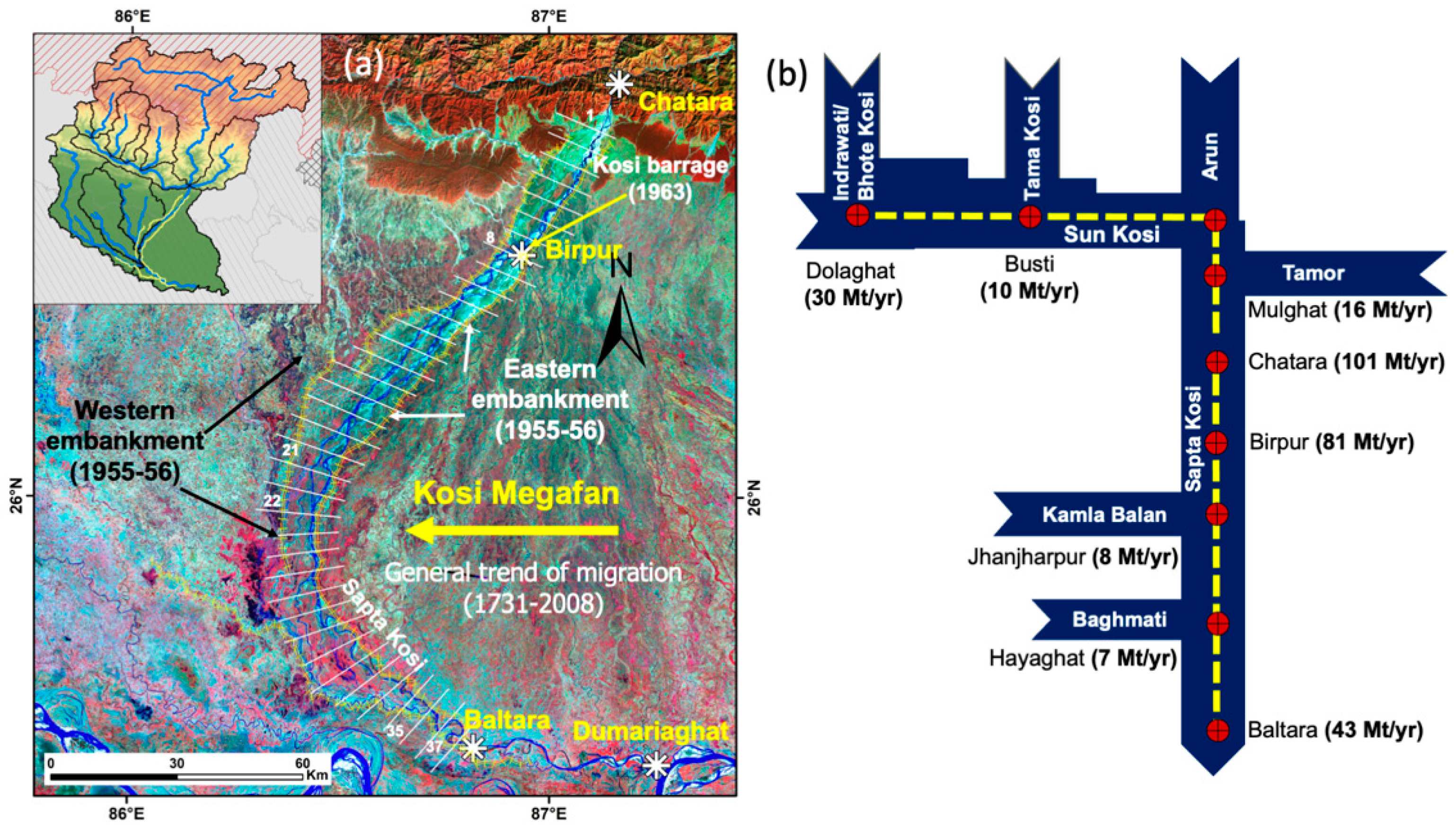
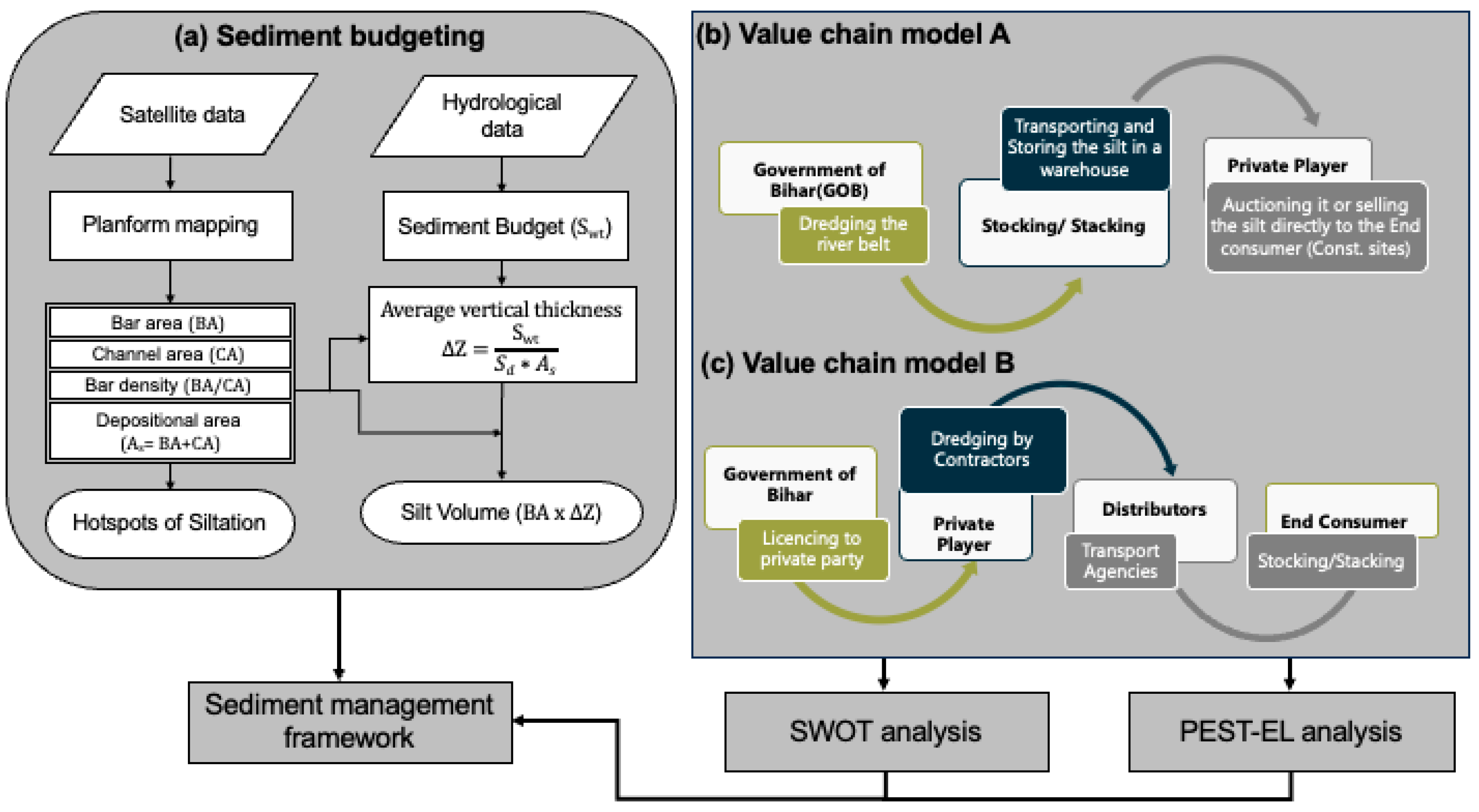
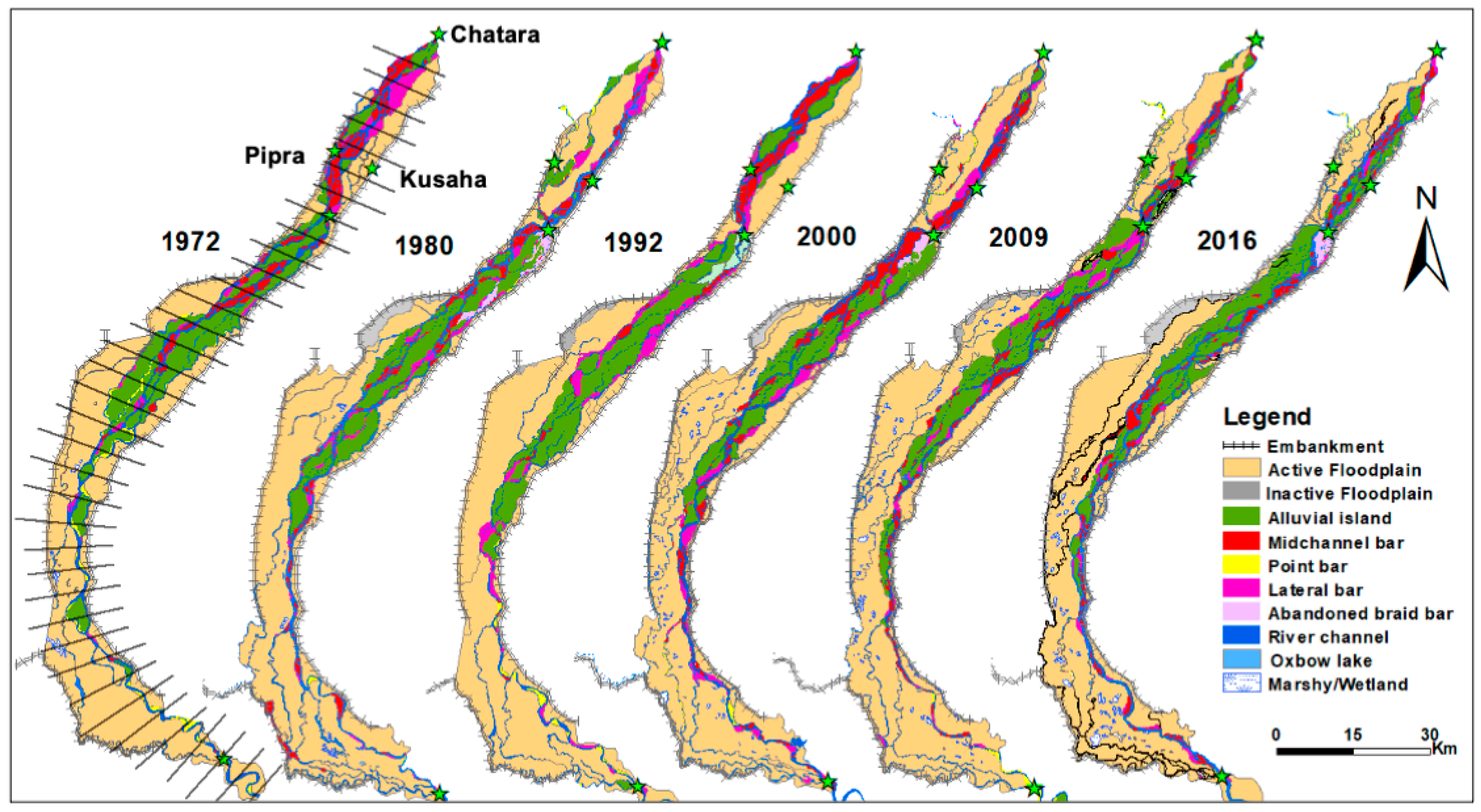
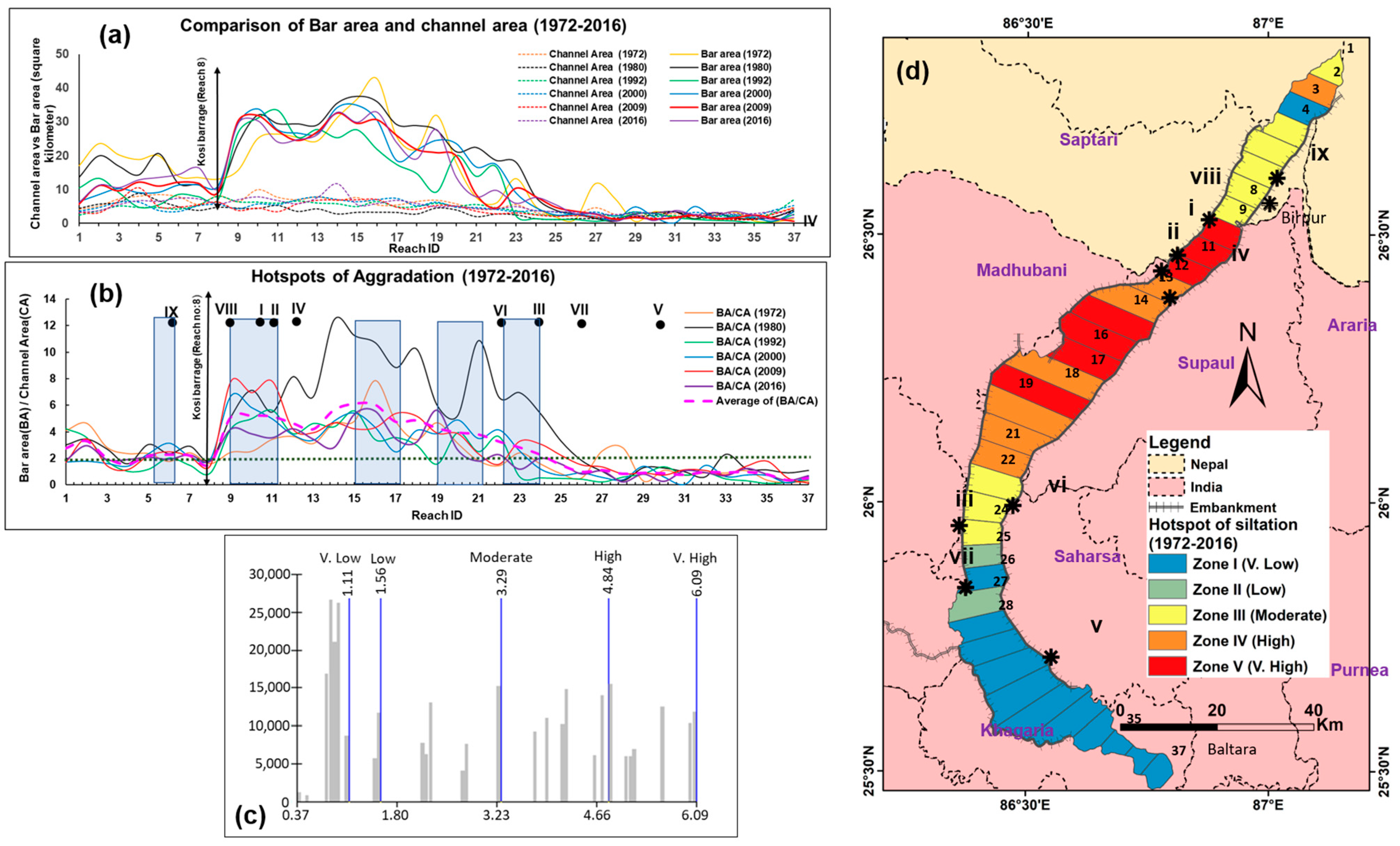
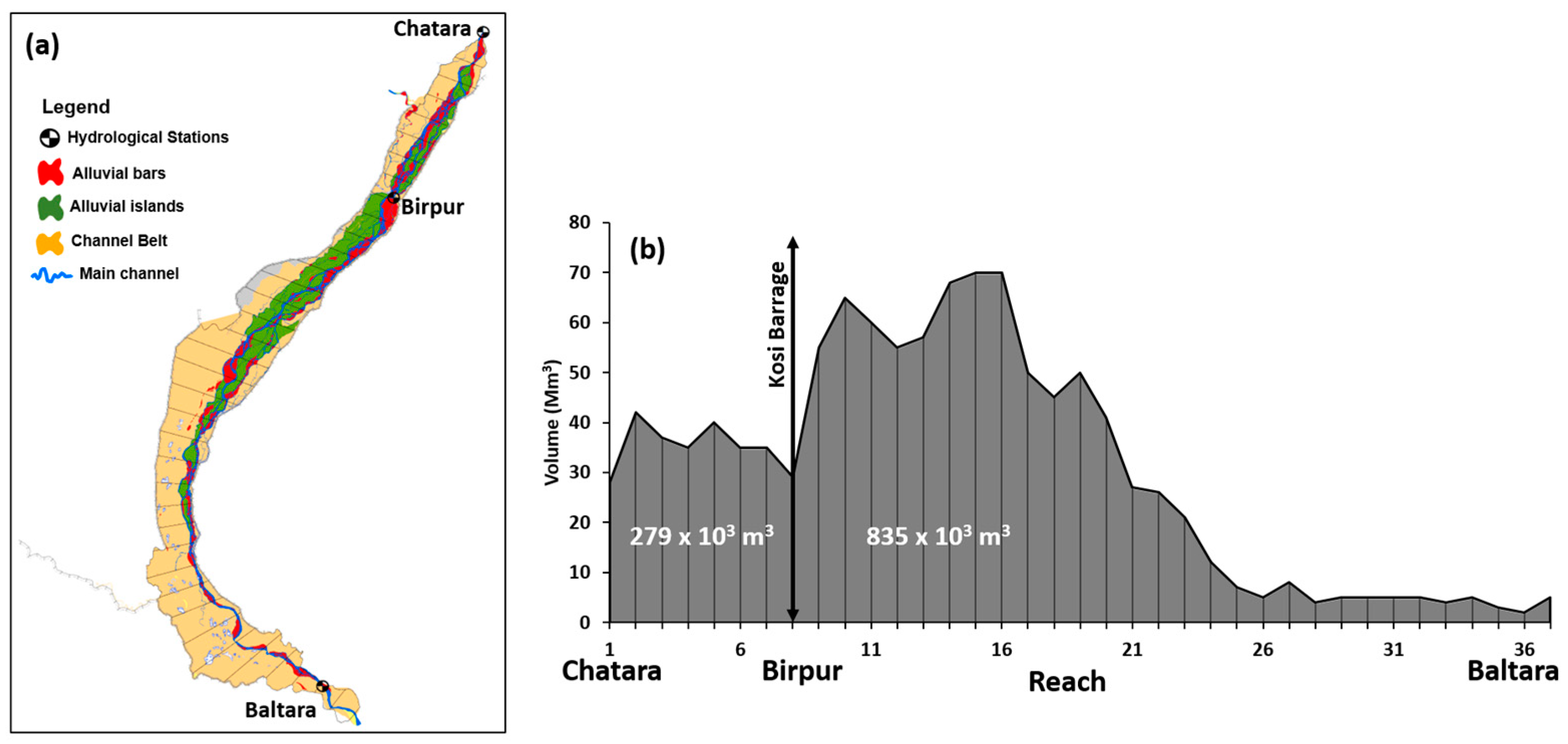

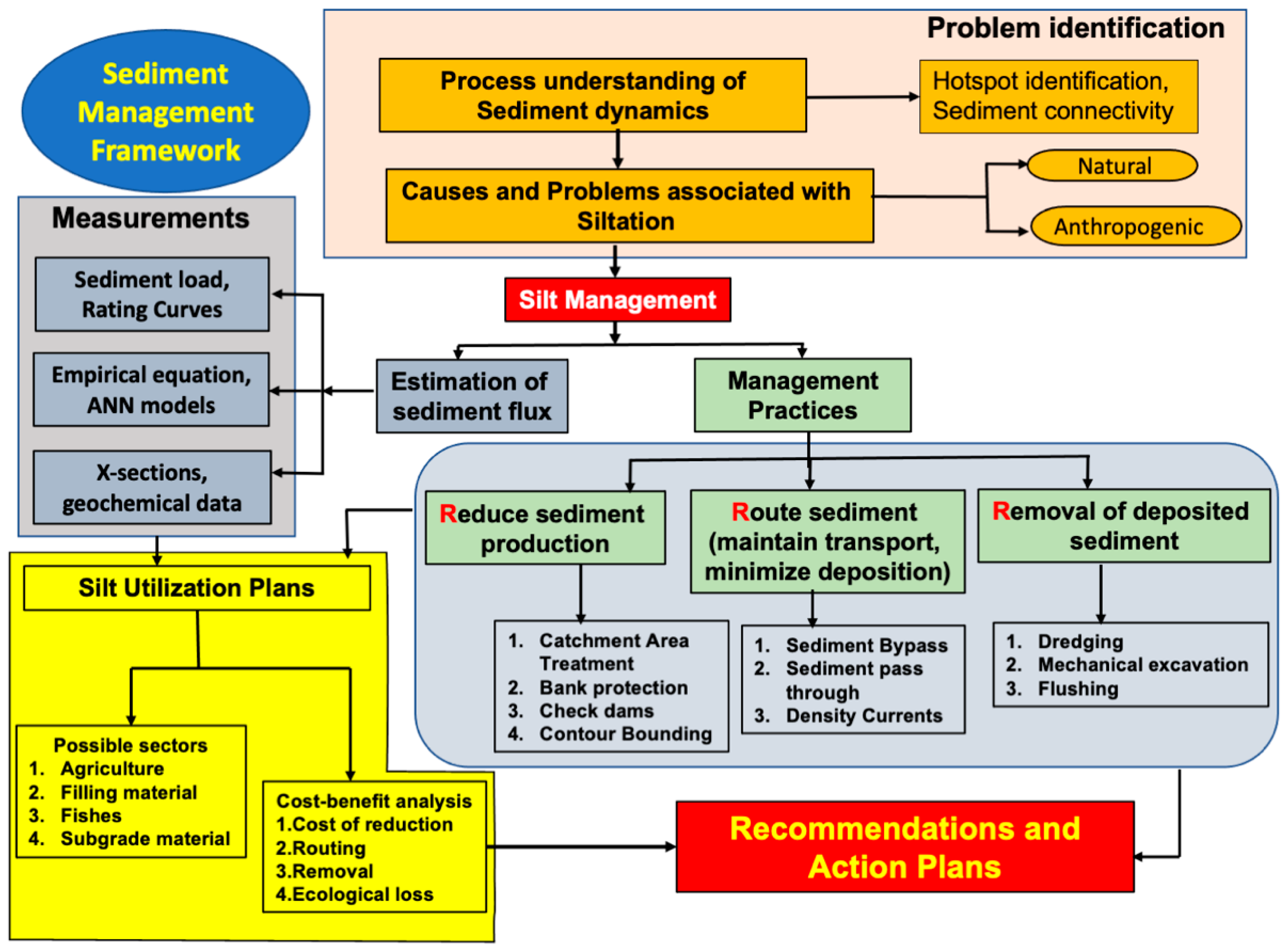
| Criteria | Description | Relative Importance |
|---|---|---|
| Scale of silt that can be utilized | This is perhaps the most important factor to determine the best solution due to the alarming problem of rising sedimentation levels. This involves the quantity of silt that can be used in the solution. | Very High |
| Social impact/non-financial benefits | This analysis involves the social and economic impact of the use of silt. Since the aim of the government is social well-being, this has been given high priority. | High |
| Non-requirement of further technical studies | Solutions, which have a proven research/case study available, can be executed on a large scale faster and in a more organized manner | Medium |
| Ease of land identification | Identification and availability of land is an important aspect in executing any solution since the quantum of silt to be managed is quite high. The ease in which land can be identified or the solution where much land space is not necessary, the execution of the solution becomes easier and faster. | Medium |
| Whether recurring or one time | A recurring activity ensures utilization of silt that gets added every year. A one-time solution may give only temporary relief, but the problem will persist after a few years. | Medium |
| Potential cost savings | Activities that involve a lower cost or saves cost on dredging/utilizing/alternate material are preferred | Low |
| Parameters | Chatara Birpur | Birpur–Baltara |
|---|---|---|
| Hydrological budgeting | ||
| Av sediment load accommodated between stations (Mt/year) | 20 | 53 |
| Total sediment deposited in 54 years (Mt) | 1080 | 2862 |
| Channel belt area/depositional area (km) | 142 | 507 |
| Sediment thickness (m) | 2.87 | 2.13 |
| Total sediment volume accumulated in 54 years (106 m3) | 408 | 1080 |
| Planform approach | ||
| Total bar area (km2) | 97.2 | 392.0 |
| Average bar height (m) | 2.87 | 2.13 |
| Total extractable sediment volume (106 m3) | 279 | 835 |
| Annual extractable sediment volume (106 m3) | 5.16 | 15.46 |
| Road Backfilling | |||
| Particulars | National Highways | State Highways and Major District Roads | Rural Roads and Minor District Roads |
| Expected new constructions (A) | 90 | 40.21 | 312.09 |
| Volume of silt per km (B) | 4500 m3 | 3150 m3 | 2475 m3 |
| Total volume of silt utilization (A) × (B) | 405,000 m3 | 126,662 m3 | 772,423 m3 |
| Total volume of silt | 1,304,085 m3 (5 Years) 260,817 m3 (Annual) | ||
| Quantum of investment required | Total working capital investment of the industry = Direct cost value of 1-month silt production | Rs 282.67 × 21,735 m3 =Rs 6,143,832 (Rs 6.1 million) | |
| Total project cost of the industry = Storage requirements (in m3) × Storage-project cost/m3 | =65,204 × 150 =Rs 9,780,600 (Rs 9.8 million) | ||
| Backfilling for Building Houses | |||
| Particulars | Saharsa | Supaul | |
| No. of households (A) | 368,979 | 443,073 | |
| Average population growth rate (B) | 2.33% | 2.55% | |
| Silt usage for filling 1 house of approx. 500 sq. ft. (C) | 38.23 m3 | 38.23 m3 | |
| Volume of silt utilization for 5 years (A) × (B) × (C) × 5 | 16,43,356 m3 | 21,59,681 m3 | |
| Total volume of silt | 3,803,037 m3 (5 Years) 760,607 m3 (Annual) | ||
| Quantum of investment required | Total working capital investment of the industry = Direct cost value of 1-month silt production | =Rs 282.67 × 63,384 m3 =Rs 179,16,755 (Rs. 17.9 million) | |
| Total project cost of the industry = Storage requirements (in m3) × Storage-project cost / m3 | =190,152 × 1353 =Rs 28,522,800 (Rs. 28.5 million) | ||
| Habitat Island Filling (for 5 Years) | |||
| Particulars | Figures | ||
| Population inside embankment (A) | 52,115 | ||
| Area required by 1 person in rural area in sq. ft (B) | 103 | ||
| Total area of island in sq. ft (C) = (A) × (B) | 5,367,845 | ||
| Total area of island in sq. meter (D) | 498,689 | ||
| Height of silt utilized in island in meters (E) | 1.5 | ||
| Total volume of silt utilization in cubic meters (D) × (E) | 748,033.50 | ||
| Particulars | Road Backfilling | Backfilling for Building of Houses | Building Road on Embankment | Implication |
|---|---|---|---|---|
| Initial investment | ~Rs 15.92 million | ~Rs 46.35 million | Nil | Initial CAPEX funding of the project |
| Annual volume of silt utilized | 2,60,817 m3 | 7,60,607 m3 | 64,350 m3 | Shows the quantity of silt dredged and utilized p.a. |
| Annual value of silt utilized commercially | ~Rs 81.9 million | ~Rs 238.8 million | ~Rs 15.2 million | Shows the market value of silt used for commercial purpose p.a. |
| Annual net benefits | ~Rs 3.66 million | ~Rs 10.68 million | ~Rs 1.003 million | Yearly revenue plus savings minus cost of the industry |
| Period of forecasting | 10 years | 10 years | 10 years | Duration of the estimation |
| Residual value at the end of the period | ~Rs 6.14 million | ~Rs 17.92 million | Working capital released plus terminal value of the project | |
| IRR of the project | 24.44% | 24.44% | Internal rate of return generated by the industry | |
| NPV of the project | ~Rs 6.2 million | ~Rs 18.1 million | Net present value of the industry | |
| Payback period of the project | 4.05 years | 4.05 years | No. of years to recover the initial investment | |
| Investment model | Model B | Model B | Model A | Model of implementation (Model A or B) |
| Particulars | Figures |
|---|---|
| Raising height of embankment (for 10 years) | |
| Length of Kosi River in red hotspots in meters (A) | 75,880 |
| Width of embankment in meters (B) | 6 |
| Height of embankment in meters (C) | 2 |
| Total volume of raised embankment m3 (D) = (A) × (B) × (C) | 910,560 |
| % Silt usage in embankment (E) | 70 |
| Total volume of silt utilization in m3 (D) × (E) for 10 years | 637,392 |
| Annual volume of silt utilization in m3 | 63,739 |
| Grand total cost of silt to be utilized in next 10 years (using dredging cost of Rs 200/m3 and construction cost of Rs 219/m3) | Rs 267.06 million |
| Annual Grand Total cost of silt to be utilized | Rs 26.71 million |
| Building road on embankment (for 10 years) | |
| Length of Kosi River in Bihar (A) | 260 km |
| Volume of silt per km (village road) (B) | 2475 m3 |
| Total volume of silt utilization for next 10 years (A) × (B) | 643,500 m3 |
| Annual grand total volume of silt utilization | 64,350 m3 |
| Strength | Weakness | Opportunities | Threats |
|---|---|---|---|
|
|
|
|
| Political Aspects | Economic Aspects |
|
|
| Social aspects | Technological aspects |
|
|
| Environmental aspects | Legal aspects |
|
|
| Phase | Time Period | Factors |
|---|---|---|
| Short-term Recommendations | 1–2 years |
|
| Medium-term Recommendations | 3–5 years |
|
| Long-term Recommendations | 6–10 years |
|
Disclaimer/Publisher’s Note: The statements, opinions and data contained in all publications are solely those of the individual author(s) and contributor(s) and not of MDPI and/or the editor(s). MDPI and/or the editor(s) disclaim responsibility for any injury to people or property resulting from any ideas, methods, instructions or products referred to in the content. |
© 2023 by the authors. Licensee MDPI, Basel, Switzerland. This article is an open access article distributed under the terms and conditions of the Creative Commons Attribution (CC BY) license (https://creativecommons.org/licenses/by/4.0/).
Share and Cite
Sinha, R.; Mishra, K.; Salunke, P.; Sounderajan, V. Sustainable Silt Management in the Lower Kosi River, North Bihar, India: Demand Assessment, Investment Model and Socio-Economic Development. Sustainability 2023, 15, 14952. https://doi.org/10.3390/su152014952
Sinha R, Mishra K, Salunke P, Sounderajan V. Sustainable Silt Management in the Lower Kosi River, North Bihar, India: Demand Assessment, Investment Model and Socio-Economic Development. Sustainability. 2023; 15(20):14952. https://doi.org/10.3390/su152014952
Chicago/Turabian StyleSinha, Rajiv, Kanchan Mishra, Priyesh Salunke, and Vidya Sounderajan. 2023. "Sustainable Silt Management in the Lower Kosi River, North Bihar, India: Demand Assessment, Investment Model and Socio-Economic Development" Sustainability 15, no. 20: 14952. https://doi.org/10.3390/su152014952
APA StyleSinha, R., Mishra, K., Salunke, P., & Sounderajan, V. (2023). Sustainable Silt Management in the Lower Kosi River, North Bihar, India: Demand Assessment, Investment Model and Socio-Economic Development. Sustainability, 15(20), 14952. https://doi.org/10.3390/su152014952





